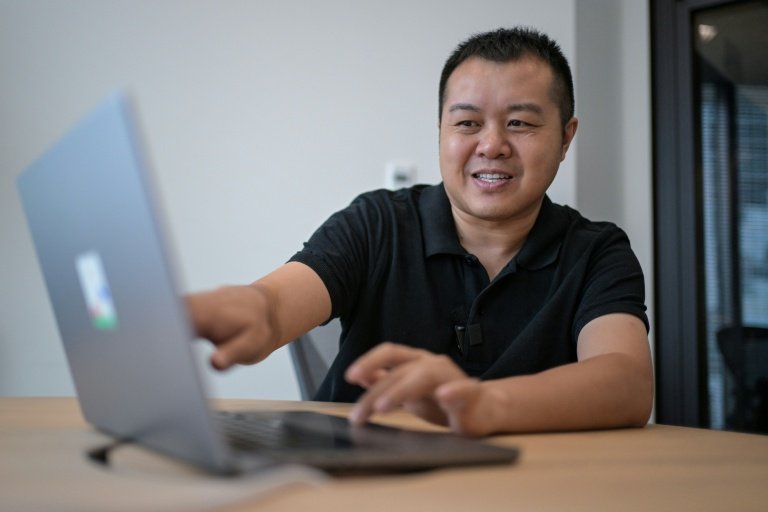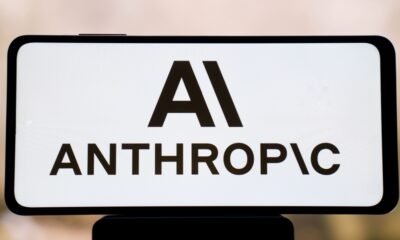Tools & Platforms
Apple’s new iPhone 17 devices don’t have an AI-powered Siri yet. It doesn’t matter.

At yet another splashy event, Apple on Tuesday introduced its latest lineup of iPhones: the iPhone 17, 17 Pro, 17 Pro Max, and a new slimmer version dubbed the iPhone Air. The “Air” branding is meant to bring to mind other lightweight — and sometimes less expensive — Apple products like the MacBook Air and iPad Air. But it also recalls a time when smartphone makers were chasing an ever-thinner phone. In the AI era, however, it’s not necessarily the device’s size that matters; it’s what the software it runs can do.
On this front, Apple has lagged its competitors.
At its iPhone 17 event, the company only referenced AI technology a few times: to rehash some updates announced in June at WWDC, like Visual Intelligence and its on-device models, and in some aspects of its camera upgrades, like the iPhone 17’s front camera, which it calls Center Stage.
The most compelling use of AI wasn’t even introduced as a phone upgrade; it was the AI-powered Live Translation feature coming to Apple’s AirPods 3.
There was no mention of Siri at all, AI-powered or otherwise.
Much has been made about how Apple’s miscalculation on AI could negatively affect its industry standing and future success. Meanwhile, Google last month rolled out its latest release of an AI-powered Android phone with its Pixel 10, as iPhone owners still await an AI Siri that’s been delayed until 2026.
Until now, Apple has only released what could be considered baseline AI features for its devices, like AI writing tools, summarization, generative AI images (which some complain are not very good), live translation, visual search, and Genmoji, among others. Yet a digital assistant that understands a wide range of questions — without deferring to ChatGPT — or one that can provide further context from your iPhone apps remains overdue.
Recently, it was reported that Apple is looking to third parties to help it catch up in the AI race. An AI-enhanced Siri could be running some other technology — like Google Gemini — under the hood.
At first glance, this delay, combined with the decision to rely on a third party — or even, possibly a sizable acquisition — seems like it could spell bad news for Apple. However, Apple’s decision to outsource some of the phone’s AI technology could actually become a selling point for consumers.
Today’s iPhone owners often swap out Apple’s technology for Google’s by opting for Gmail, Google Drive and Docs, Google Maps, and Chrome over Apple’s own apps like Mail, its iWork suite, Apple Maps, and Safari, for example. When people search the web, they turn to Google’s Search app, not Apple’s built-in Spotlight search, despite its many integrations over the years to offer basic facts and answers, leveraging sources like Wikipedia. Why, then, shouldn’t they be able to use Google’s AI technology, too?
If Apple does proceed with a third-party deal to integrate AI into its devices, it may work out to be an even bigger win for iPhone owners. It would mean that high-performing AI technology would be integrated into the device more natively. It would feel more seamless, more a part of the iPhone experience itself than simply running an AI app. And Apple could get there without having to invest as heavily in the infrastructure required to compete in the AI race, which is good for the company’s (already healthy) bottom line.
Plus, given the speed with which AI technology has been evolving, this design would leave room for Apple to swap out models or expand support to include others, as AI companies edge themselves ahead of others.
The result for consumers would be the best of both worlds: the aesthetics and hardware quality (thinness and all!) of the iPhone, with Google’s technology (or Anthropic’s or OpenAI’s) powering some of the key AI components. That could also be beneficial to Apple’s overall brand.
It also means that the look-and-feel of updated iPhones themselves and their hardware advances will continue to drive sales and upgrades, allowing Apple to do what it does best: focus on build quality, camera improvements, privacy-preserving tech, intentional software design changes like Liquid Glass — and yes, super thin phones.
Apple could continue to market itself as a best-in-class hardware maker first, not an AI device maker; customers could still long for the latest iPhones, as always, without having to sacrifice the latest technology advances when they make the choice to buy a phone from Apple.
Of course, this scenario only plays out if and when Apple opts to launch a version of Siri that runs a third-party’s AI technology to enhance its own. (Or if it buys an AI company). But if Apple decides to only rely on its Apple Intelligence offerings without getting them up to speed quickly, the outcome could be much different.
Tools & Platforms
Top Japan start-up Sakana AI touts nature-inspired tech – personcountylife.com

Top Japan start-up Sakana AI touts nature-inspired tech personcountylife.com
Source link
Tools & Platforms
The challenge goes beyond merely understanding how AI works

As AI evolves from simple automation to sophisticated autonomous agents, HR executives face one of the most significant workforce transformations in modern history. The challenge isn’t just understanding the technology — it’s navigating culture change, skills development and workforce planning when AI capabilities double every six months.
Simon Brown, EY’s global learning and development leader, has spent nearly 2 years helping the firm’s 400,000 employees prepare for an AI-driven future. With his past experience as chief learning officer at Novartis and his work with Microsoft, Brown offers critical insights on positioning organizations for success in an autonomous AI world.
What are the top questions C-suite executives need to ask their teams about agentic AI initiatives?
Are people aware of what’s possible with agents? Are we experimenting to find ways agents can help us? Do we have the skills and knowledge to do that properly?
But the most critical question is: Is the culture there to support this? Most organizations are feeling their way through which tools work, what the use cases are, what drives value. There’s a lot of ambiguity. Some organizations manage well through uncertainty; others need clear answers and can’t fail — that’s hard when there’s no clear path and people need to experiment.
How can leaders assess whether their organization has the right culture for agentic AI?
Look at how AI tools like Microsoft Copilot are being embraced. Are people experimenting and finding productivity value, or are they threatened and not using it? If leaders are role modeling use and encouraging their people, that comes through in adoption metrics. Culture shows through communication, leadership role modeling, skill building and time to learn.
What are common blind spots when executives evaluate AI readiness?
Two major issues. First, executives often aren’t aware of what’s possible with the latest AI systems due to security constraints and procurement processes that create 6-to-12-month lags.
Second, the speed of improvement. If I tried an AI tool a month ago versus today, I may get a completely different experience because the underlying model improved. Copilot now has GPT-5 access, giving it a significant overnight boost. Leaders need to shift from thinking about AI as static systems upgraded annually to something constantly improving and doubling in power every six months.
How should leaders approach change management with AI agents?
Change management is essential. When OpenAI releases new capabilities, everyone has access to the technology. Whether organizations get the benefit depends entirely on change management — culture, experimentation ability, skills and whether people feel encouraged rather than fearful. We’re addressing this through AI badges, curricula, enterprise-wide learning — all signaling the organization values building AI skills.
What’s your framework for evaluating whether AI investment will drive real business value?
I think about three loops. First, can I use this to do current tasks cheaper, faster, better? Second, can I realize new value — serving more customers, new products and services? Third, if everyone’s using AI, how do we reinvent ourselves to create new value? It’s moving beyond just doing the same things better to what AI helps us do differently.
How should HR leaders rethink workforce planning given AI’s potential to automate job functions?
Understand which skills AI will impact, which remain uniquely human and what new roles get created. The World Economic Forum predicts significant reduction in certain roles but net increase overall. We’re seeing new, more sophisticated roles created that move people higher up the value chain.
From HR’s perspective, are our processes still fit for AI speed? How are we incentivizing reskilling? Are we ensuring learning access and time? How are we signaling which skills are in demand versus at risk of automation?
How should HR measure success after implementing agentic AI?
Tie back to why it was implemented — business value. Use similar metrics as before but look at what changed. Maybe same output but cheaper, faster, better. Or new capabilities — our third-party risk team uses agents to provide much more extensive supplier analysis than before. Same team size, more client value.
What’s your timeline perspective on when agentic AI becomes competitive necessity versus advantage?
That’s the ultimate question. I’m amazed daily by what I achieve using AI and agents. ChatGPT-5’s recent capabilities are mind-blowing, suggesting dramatic impact quickly. But when deep AI experts have vastly different views — from AGI around the corner to decades away — it’s understandable why leaders struggle to navigate this landscape.
Tools & Platforms
Top Japan start-up Sakana AI touts nature-inspired tech

When David Ha started an AI company in Japan with his former Google colleague, they had a choice: create another huge, energy-intensive tool like ChatGPT, or go their own way.
Since its 2023 launch, the value of their firm Sakana AI has soared past $1 billion, becoming Japan’s fastest start-up to reach so-called unicorn status.
“In a space like AI, everyone’s kind of doing the same thing. They’re just like collecting the world’s data, building a gigantic model, sucking up all this energy,” Ha told AFP.
For a new venture, “the chance of success is actually quite low, especially in Japan”, where the resources to run power-hungry data centres are scarce.
Instead of going head-to-head with top players like OpenAI or Alibaba, Sakana aims to merge existing and new systems, large and small, to develop what it calls “collective intelligence”.
In many countries, “people are debating, should I use a Chinese model or should I use a US model?” Ha said, referring to AI foundation models trained on vast amounts of data.
But in today’s tumultuous world, “you can imagine… a scenario where a certain provider might turn off their models”, he added.
Combining the best aspects of multiple systems means Sakana’s AI-powered programmes could in theory “continue to operate”, he said, even if “with slightly lower performance at the beginning”.
Sakana’s approach has won it the support of US chip giant Nvidia as well as Japanese banks and other businesses keen to get ahead in the fast-moving world of generative artificial intelligence.
The word sakana means fish in Japanese, and the start-up says it is inspired by nature, where species from ants to humans collaborate to solve problems.
– ‘Soft power’ –
Ha, a Hong Kong-born Canadian and long-term Japan resident, is a former Google Brain research scientist who previously traded derivatives for Goldman Sachs.
He founded Sakana AI with ex-Google researcher Llion Jones, co-author of a groundbreaking 2017 machine learning paper, and Ren Ito, who has held positions in Japan’s foreign ministry.
Sakana’s team numbers more than 100, including contractors, and its unassuming offices are located in a shared Tokyo start-up space.
Japan is pouring tens of billions of dollars into AI and semiconductors, hoping to claw back some of its 1980s tech glory and boost the productivity of its shrinking workforce.
But there is some way to go. In academic institute IMD’s 2025 World Competitiveness Ranking, Japan came 35th, with researchers saying it needs to foster entrepreneurship and address labour shortages caused by its ageing population.
-

 Business2 weeks ago
Business2 weeks agoThe Guardian view on Trump and the Fed: independence is no substitute for accountability | Editorial
-
Tools & Platforms4 weeks ago
Building Trust in Military AI Starts with Opening the Black Box – War on the Rocks
-

 Ethics & Policy1 month ago
Ethics & Policy1 month agoSDAIA Supports Saudi Arabia’s Leadership in Shaping Global AI Ethics, Policy, and Research – وكالة الأنباء السعودية
-

 Events & Conferences4 months ago
Events & Conferences4 months agoJourney to 1000 models: Scaling Instagram’s recommendation system
-

 Jobs & Careers2 months ago
Jobs & Careers2 months agoMumbai-based Perplexity Alternative Has 60k+ Users Without Funding
-

 Podcasts & Talks2 months ago
Podcasts & Talks2 months agoHappy 4th of July! 🎆 Made with Veo 3 in Gemini
-

 Education2 months ago
Education2 months agoMacron says UK and France have duty to tackle illegal migration ‘with humanity, solidarity and firmness’ – UK politics live | Politics
-

 Education2 months ago
Education2 months agoVEX Robotics launches AI-powered classroom robotics system
-

 Funding & Business2 months ago
Funding & Business2 months agoKayak and Expedia race to build AI travel agents that turn social posts into itineraries
-

 Podcasts & Talks2 months ago
Podcasts & Talks2 months agoOpenAI 🤝 @teamganassi



















